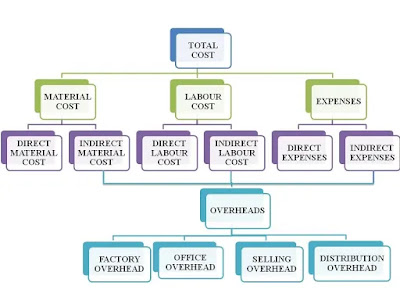We often discuss about the cost accounting and we will end up with the various questions in our head without
answer or answers to very few questions. So today I decided to answer one such
question that’s “What are the Elements of Cost”. Today in this article
we will learn and will try to understand the elements of cost.
ELEMENTS OF COST
 |
| Elements of Cost |
From the above chart of elements of
cost total cost can be divided mainly into Material cost, Labor cost and
Expenses. Further Material cost can be divided into direct material cost and
indirect material cost, Labor cost can be divided into direct labor cost and
indirect labor cost and Expenses into direct expenses and indirect expenses.
Now let’s discuss each one of the cost
and try to understand it below.
§ Total Cost:
Total cost
refers to the cost of production by adding up all the expenses to produce a
product or purchase an investment or acquisition of plant and machinery. Total
cost is mainly classified into material cost, Labor cost and Expenses.
§ Material Cost:
Material Cost
refers to cost incurred in procurement of the raw material, consumable stores
and so on. The material cost is further divided into two types of material cost
namely direct material cost and indirect material cost.
·
Direct
Material Cost :
Direct Material
cost refers to cost of material which can be identified in the final product
produced. For instance, wood used in furniture.
·
Indirect
Material Cost:
Indirect
Material cost refers to material cost which can be identified in the final
product produced but cannot be directly related to the product produced. For
Instance, Nails and threads used in preparing shoe.
§ Labor Cost:
Labor cost
refers to the remuneration paid to labor such as wages, salaries, commission
and so on. The labor cost can be further divided into direct labor cost and
indirect labor cost.
·
Direct
Labor Cost:
Direct labor
Cost refers to the remuneration paid to the labors who are involved directly in
the production activities.
·
Indirect
Labor Cost:
Indirect Labor
cost refers to the remuneration paid to the workers who are not directly
involved in the production activities. For instance, wages paid to office
workers.
§ Expenses:
Expenses refer
to the cost incurred during production other than material and labor cost by a
business. Expenses are further divided into direct and indirect expenses.
·
Direct
Expenses:
Direct Expenses
refers to the cost which incurred directly and can be easily identified by the
cost centre or cost unit. For Instance, Production Expenses
·
Indirect
Expenses:
Indirect Expenses as known as fixed
expenses. Indirect or fixed expenses refer to those expenses that don’t vary
with respect to the quantity produced.
Now
let us see some of the examples for the above elements of cost below in the chart.
|
Particulars
|
Elements of Cost
|
|
Wages paid to
sweepers, wages paid to maintenance workers, Nails used in Shoe, Oils used
for lubricating machines, Factory Stationary, Directors fees (Factory),
Unproductive Wages, Estimation Expenses, Water Supply, Haulage, Experimental
Expenses, Sale of Scrap, Convertible Materials, Welfare Expenses and more.
|
Factory
Overhead
|
|
Salesman
Commission, Agent Commission, Warehouse Salary, Discount on Sales, Bad debts,
Travelling Expenses, Depreciation on Delivery Van, Upkeep of Delivery Van,
Material used in selling a product and more.
|
Selling and
Distribution Overhead
|
|
Paper used
for printing paper, Bags used for Packaging, Material used in Packaging and
more.
|
Direct
Material Cost
|
|
Wages paid to
piece workers and more.
|
Direct Labor
Cost
|
|
Bank Charges,
General Expenses, Legal Expenses, Counting house salaries, Establishment
Expenses, Royalty, Branch office Expenses and more.
|
Office
Overhead
|
|
Special
design, Carriage on Material, Chargeable Expenses, Exercise Duty and more.
|
Direct
Expenses
|
Comments
Post a Comment